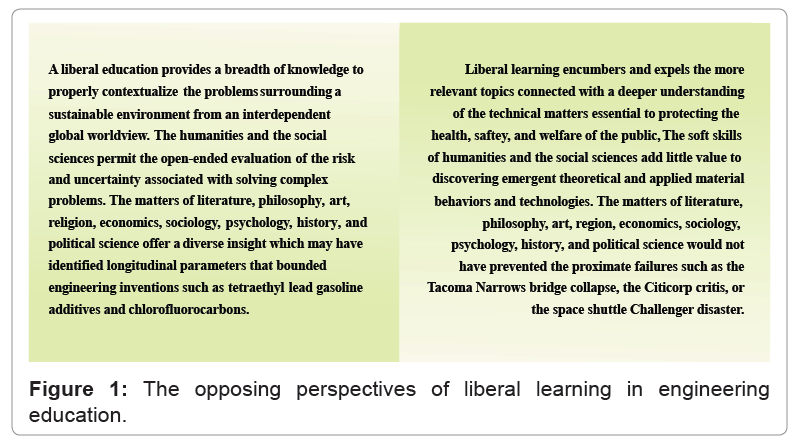The Polarities of Liberal Engineering
Received: 14-Dec-2012 / Accepted Date: 14-Dec-2012 / Published Date: 15-Dec-2012 DOI: 10.4172/2168-9717.1000e110
74089The engineering accreditation board [1], a lead disciplinary society [2,3], and the national licensure society [4] have recognized that an appropriate response to the pressing issues confronting engineering education is to advance the notions of a liberal education. Some critical issues are the pace of technological change, the social contextualization, and acquiring a systems perspective in the profession. The National Academy of Sciences specifically recommends the promotion of the humanities and social sciences in engineering education [5]. However, this charge is not a consensus among engineers and is “a continuous and sometimes contentious debate about the role of liberal studies (humanistic and social science courses) in preparing the professional engineer” [5]. Figure 1 illustrates a divergent point and counterpoint regarding the development of liberal topics in an undergraduate engineering education.
“Engineering is one of the most practical of the professions; the engineer and his clients are immediately confronted with the very tangible results of his practice. This very direct functionalism is one of the most attractive things about the profession, but it may also explain why engineers have so long neglected studies of long-range value and of great eventual functional importance” [6]. The engineer’s accountability is under instantaneous scrutiny when failure occurs. The most common disasters in the public domain fall within the disciplinary knowledge areas such as the undiscovered effects of aeroelastic fluttering [7] or quartering winds [8] associated with the Tacoma Narrows bridge collapse and the Citicorp building, respectively. The engineer is predisposed to this liability and is encouraged to pursue a critical depth of knowledge. Since there are a finite number of credits in an undergraduate curriculum, core subject areas within the discipline would best serve the engineering students rather than engaging in the soft skills.
Charles Vest noted, “Don’t be tempered to crowd the humanities, arts, and social sciences out of the curriculum. The integral role of these subjects in U.S. engineering education differentiates us from much of the rest of the world. I believe the humanities, arts, and social sciences are essential to the creative, explorative, open-minded environment and spirit necessary to educate the engineer of 2020” [9]. Although the time contracted issues central to engineering design are of critical importance, the engineering society sees a need for a body of knowledge that longitudinally forecasts in a manner that responds to the broader and interdependent concerns. Some call for a liberal arts degree prior to entering engineering programs [10], while others suggest adding one year to the education standard [2]. Seely [11] cites a historically relevant observation from Wickenden [12] as a possible resolution, “A broader grounding in its principles and methods, and a more general postponement of specialized training to the graduate schools and to the stage of introductory experience which marks the transition to active life” [11]. This issue is more than a century old.
References
- ABET Engineering Accreditation Commission (2012) 2013-2014Criteria for accrediting engineering programs. Baltimore, MD: ABET.
- Committee on Academic Prerequisites for ProfessionalPractice (2007) ASCE policy statement 465: Academic prerequisites for licensureand professional practice. Reston, VA: ASCE.
- Committee on Academic Prerequisitesfor Professional Practice (2007) Key points about ASCE Policy Statement 465.Reston, VA: ASCE.
- National Society of ProfessionalEngineers (2010) NSPE position statement no. 1752-Engineering educationoutcomes.
- National Academy of Sciences (2005) Educating theengineer of 2020: Adapting education to the new century. Washington, DC: TheNational Academies Press
- Sawyer HA (1951) Humanities forengineering students. The Journal of Higher Education 22: 470-475.
- Larsen A, Walther JS (1997)Â Aeroelastic analysis of bridge girder section based on discrete vortexsimulations. Journal of Wind Engineering and Industrial Aerodynamics 67 : 253-265.
- Morgenstern J (1997) Thefifty-nine-story crisis. Journal of Professional Issues in Engineering Educationand Practice 123: 23-29.
- Vest CM (2005) Educating engineers for 2020 andbeyond. In National Academy of the Sciences (Ed.) Educating the Engineer of2020: Adapting Education to the New Century. Washington, DC: The NationalAcademies Press 160-169.
- Duderstadt JJ (2009) Engineering fora changing world: A roadmap to the future of engineering practice, research,and education. The Millennium Project. Ann Arbor, MI: The University ofMichigan.
- Seely BE (2005) Patterns in the history of educationreform: A brief essay. In National Academy of the Sciences (Ed.) Educating theEngineer of 2020: Adapting Education to the New Century. Washington, DC: TheNational Academies Press
- Wickenden W (1927) Memo to SPEE Board of Investigation and Coordination. Washington, DC:ASEE Archives.
Citation: Hedges KE (2012) The Polarities of Liberal Engineering. J Archit Eng Tech 2: e110. DOI: 10.4172/2168-9717.1000e110
Copyright: ©2012 Hedges KE . This is an open-access article distributed under the terms of the Creative Commons Attribution License, which permits unrestricted use, distribution, and reproduction in any medium, provided the original author and source are credited.
Select your language of interest to view the total content in your interested language
Share This Article
Recommended Journals
Open Access Journals
Article Tools
Article Usage
- Total views: 14285
- [From(publication date): 7-2013 - Jul 01, 2025]
- Breakdown by view type
- HTML page views: 9740
- PDF downloads: 4545

